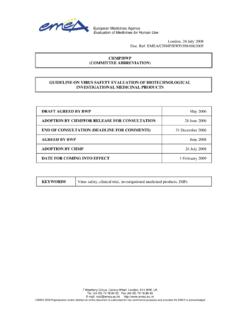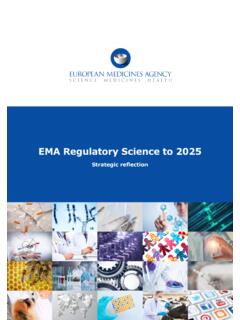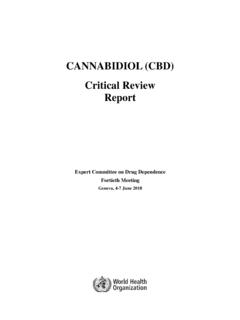Transcription of HTM 2010 Sterilization: Management policy
1 Health Technical Memorandum 2010. Part 1: Management policy Sterilization London: HMSO. Crown copyright 1994. Applications for reproduction should be made to HMSO. First published 1994. ISBN 0 11 321739 0. HMSO. Standing order service Placing a standing order with HMSO BOOKS enables a customer to receive future titles in this series automatically as published. This saves the time, trouble and expense of placing individual orders and avoids the problem of knowing when to do so. For details please write to HMSO. BOOKS (PC 13A/1), Publications Centre, PO Box 276, London SW8 5DT quoting reference The standing order service also enables customers to receive automatically as published all material of their choice which additionally saves extensive catalogue research. The scope and selectivity of the service has been extended by new techniques, and there are more than 3,500.
2 Classifications to choose from. A special leaflet describing the service in detail may be obtained on request. About this publication Health Technical Memoranda (HTMs) Part 2 Design considerations . give comprehensive advice and guidance contains information relevant to the on the design, installation and operation specification and installation of new of specialised building and engineering sterilizing equipment. It discusses the technology used in the delivery of requirements for each type of healthcare. sterilizer and outlines the specifications to be included in any They are applicable to new and existing contract. Practical considerations for sites, and are for use at various stages the installation of sterilizers are during the inception, design, construction, discussed, including siting, heat refurbishment and maintenance of a emission, ventilation, noise and building.
3 Vibration, and mains services with an emphasis on steam quality;. Health Technical Memorandum 2010. HTM 2010 is being published in five Part 3 Validation and parts: verification covers all aspects of validation and periodic testing of this volume (Part 1) Management sterilizers. It includes detailed policy is a summary of the schedules and procedures for tests information required by non-technical and checks to be carried out for personnel responsible for the commissioning and performance Management of sterilization services. qualification, and for subsequent It discusses the various types of periodic testing;. sterilizer, for both clinical and laboratory use, and contains guidance Part 4 Operational on legal and policy matters, and on Management covers all aspects of the appointment and responsibilities the routine operation and of personnel.
4 It should be read by maintenance of sterilizers, stressing anyone consulting this memorandum the need for a planned maintenance for the first time; programme along with the type of records to be kept. Advice on the safe and efficient operation of sterilizers is given, as well as procedures for a. the Welsh Office for the NHS in reporting defects and accidents; Wales;. Part 5 Good practice guide b. the Health and Personal Social provides advice on the fatigue life of Services Management Executive in pressure vessels, operational Northern Ireland;. procedures guidance on the control of sterilizers, and use of the C. the National Health Service in supplementary publications (logbooks Scotland Management Executive. etc.). It also includes a comprehensive bibliography. References to legislation appearing in the main text of this guidance apply to the The contents of this HTM in terms of United Kingdom as a whole, except Management policy and operational where marginal notes indicate variations policy are endorsed by: for Scotland or Northern Ireland.
5 Contents About this publication Manual Handling Operations Regulations 1992. 1 Sterilization and the role of Personal Protective Equipment at Work Management page 3 Regulations 1992. Introduction Medicinal products The European Union Directives on medical devices Medicines Act 1968. Definition of medical device Medicines (Standard Provisions of Licences The three Directives and Certificates) Amendment (No 3). The regulatory framework Regulations 1977. Impact on sterilization Medicines (Standard Provision of Licences Summary of Management responsibilities and Certificates) Amendment Regulations 1992. 2 Sterilizers an overview page 7 Consumer protection Introduction Consumer Protection Act 1987. Clinical sterilizers using high-temperature steam Electromagnetic Compatibility Regulations 1992. Porous loads Active Implantable Medical Devices Regulations Fluids 1992.
6 Unwrapped instruments and utensils Clinical sterilizers using hot air 4 British and European standards page 18. Clinical sterilizers using low-temperature steam Introduction and formaldehyde European standards Clinical sterilizers using ethylene oxide Laboratory sterilizers/autoclaves 5 Personnel page 19. Operating cycles Introduction Culture media preparator Training Koch steamer Functional responsibility Animal house sterilizer Key personnel Management 3 Statutory requirements page 13 User Introduction Competent person (pressure vessels). Health and safety Authorised person (sterilizers). Health and Safety at Work etc Act 1974 Test person (sterilizers). Management of Health and Safety at Maintenance person (sterilizers). Work Regulations 1992 Microbiologist (sterilizers). Workplace (Health, Safety and Welfare) Personnel for medicinal products Regulations 1992 Production manager Provision and Use of Work Equipment Quality controller Regulations 1992 Other personnel Pressure Systems and Transportable Gas Containers Regulations 1989 Other publications in this series page 25.
7 Control of Substances Hazardous to Health Regulations 1988 About NHS Estates page 26. Reporting of Injuries, Diseases and Dangerous Occurrences Regulations 1985. Sterilization and the role of Management Introduction The fundamental cause of this disaster is to be found in human failings ranging from simple carelessness to poor Management of men and plant. The Committee heard of no imminent technological advance in the field of production of intravenous fluids which will eliminate the need for skilful men devoted to their work .. Too many people believe that sterilization of fluids is easily achieved with simple plant operated by men of little skill under a minimum of supervision .. Public safety in this, as in many other technological fields, depends ultimately on untiring vigilance .. The quotation above comes from the principal conclusions of the committee chaired by Sir Cecil Clothier and appointed to investigate an incident in which five patients died as a result of a faulty sterilizer.
8 The tragedy led to a thorough overhaul of the methods of managing sterilizers, among which was the revision of this Health Technical Memorandum (then HTM 10), the last edition of which was published in 1980. No disaster on a comparable scale has been reported since. Nonetheless, both the law and public opinion are now less forgiving of lapses than they were two decades ago. Tighter statutory control, resulting from new European Union (EU) Directives, will soon extend to almost every aspect of sterilization, and practices which were common a few years ago will no longer be acceptable or even lawful. The science and art of sterilization are complex and subtle. The testing, maintenance and reporting procedures described in this HTM may seem excessive to some, but they are based upon good practice in both the UK and Europe, as formalised in European Standards designed to support the new EU.
9 Directives. The European Union Directives on medical devices Until now, statutory controls on the practice of sterilization, other than in the manufacture of medical products, have been few. The major Acts and Regulations which are likely to affect the Management of a sterilizer are described in Chapter 3, but specific references to sterilization in the legislation are rare. This will change as a series of three EU Directives come into effect regulating the safety, quality and effectiveness of medical devices. This section summarises basic information about the Directives. Further details are available from the Medical Devices Agency of the Department of Health. Definition of medical device The Directives define a medical device as any instrument, apparatus, appliance, material or other article, whether used alone or in combination, including the software necessary for its proper application intended by the manufacturer to be used on human beings for the purpose of: Previous page is blank Sterilization and the role of Management a.
10 Diagnosis, prevention, monitoring, treatment or alleviation of disease;. b. diagnosis, monitoring, treatment, alleviation or compensation of an injury or handicap;. c. investigation, replacement or modification of the anatomy or of a physiological process;. d. control of conception;. and which does not achieve its principal intended action in or on the human body by pharmacological, immunological or metabolic means, but which may be assisted in its function by such means (Council Directive 93/42/EEC). The Directives apply equally to accessories . An accessory is defined as an article which, whilst not being a device, is intended specifically by its manufacturers to be used together with a device to enable it to be used in accordance with the use of the device intended by the manufacturer of the device . The three Directives The three EU directives are as follows: a.



